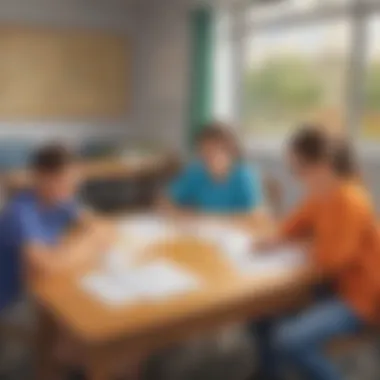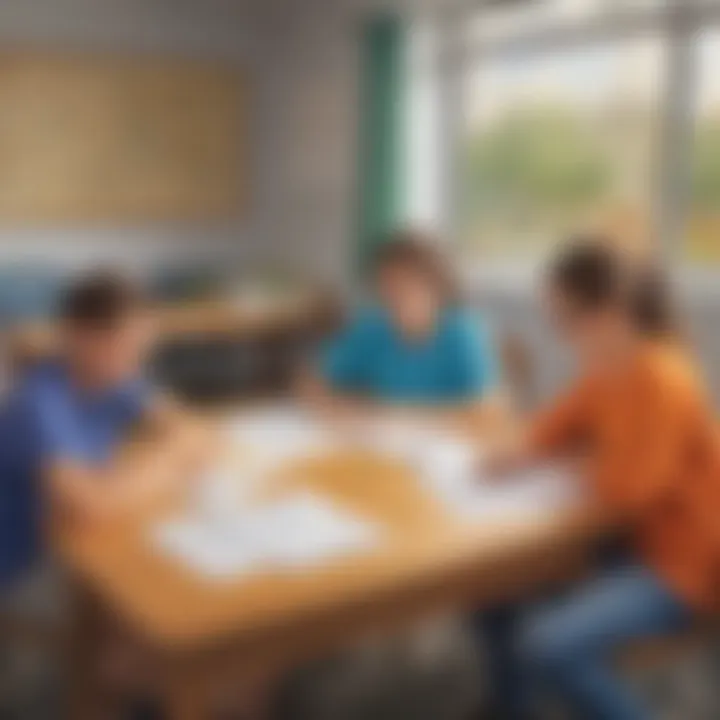Mastering Fraction Word Problems for 5th Graders


Intro
Understanding fractions is essential for 5th graders. The shift from whole numbers to fractions can introduce challenges for some students. Word problems involving fractions often mirror real-life situations. These problems are very useful for developing mathematical thinking. They bring together skills like critical thinking and problem-solving.
The ability to work with fractions is critical for a student's mathematical development. Students learn how to compare, add, subtract, and use fractions in various situations. Fraction word problems teach these skills through context. When students see how math applies in everyday life, they often gain a deeper comprehension.
This article aims to clarify the tactics to solve fraction word problems. We will look at various approaches, especially those suitable for 5th graders. It will consider how to deploy creative activities, fun quizzes, and factual articles effectively.
Creative Activities
Engaging students in creative activities fosters willingness to learn. It fortifies their understanding of fractions. Here are some activities tailored for 5th graders.
Craft Ideas
One effective method involves creating fraction cards. Students can use colored paper to represent different fractions. For example, crafting a card for one-half might involve coloring one half of the card in a specific color and leaving the other half blank. This visual representation can reinforce understanding.
Step-by-Step Guides
To create fraction cards:
- Gather materials: colored paper, scissors, and markers.
- Cut paper into rectangles, marking halves, thirds, and quarters.
- Have students label each fraction clearly.
- Use them in group activities to quiz each other.
Educational Value
These activities promote engagement. They transform abstract concepts into tangible forms. Crafting provides a hands-on approach to learning. Students develop fine motor skills while solidifying their grasp of fractions.
Fun Quizzes
Quizzes can be an excellent way to reinforce mathematics knowledge. They can assess and develop the understanding of fraction concepts.
Quiz Topics
Topics on fraction word problems may include addition, subtraction, and comparison of fractions. Each quiz can also touch upon real-world applications.
Question Types
Activities are not just limited to multiple-choice questions. Incorporating various types like fill-in-the-blank, true/false, and scenario-based questions makes quizzes dynamic and engaging.
Knowledge Reinforcement
Regular quizzes provide effective feedback. Repeated exposure to similar problems helps deepen understanding. Most importantly, both students and educators can identify areas needing improvement through these assessments.
Fact-Based Articles
Reading can cultivate a richer comprehension of fractions. Fact-based articles provide valuable insights and information.
Topics
Articles can include topics like the history of fractions, methods for simplifying fractions, and applications in cooking and trades. Such topics not only enhance knowledge but can make fractions relatable.
Engaging Content
Well-structured articles present information clearly, often simplifying complex concepts. Utilizing images and diagrams can make reading more interactive, especially for younger audiences.
Understanding Fractions
Understanding fractions is a fundamental aspect of mathematics for 5th graders. Mastery of fractions lays a crucial groundwork for more complex concepts encountered in later grades. It represents a number that expresses a part of a whole. When students grasp this idea, they can navigate the practical applications of fractions in daily life, such as in cooking, average scores, or even sharing things. This provides a concrete frame of reference that enriches their comprehension.
Definition of Fractions
A fraction consists of two main components: the numerator and the denominator. The numerator indicates how many parts we have, while the denominator shows how many total parts make up a whole. For instance, in the fraction 3/4, '3' is the numerator and '4' is the denominator.


Grasping this definition allows students to see fractions not merely as abstract numbers but as entities that help quantify portions of items or groups. It is vital for future algebraic learning as students encounter more intricate number operations.
Types of Fractions
Fractions can be categorized into distinct types, each serving different purposes in math. Recognizing these types is essential because it helps students understand how to apply fractions in various scenarios involving numbers and quantity.
Proper Fractions
Proper fractions are defined as fractions where the numerator is less than the denominator. For examples: 1/2 or 3/5 are proper fractions. This type is beneficial for students because they usually imply values less than one. Therefore, they tend to be straightforward in conceptualizing how fractions relate to whole numbers.
In word problems, proper fractions often appear when discussing quantities that are distributed or used in smaller parts.
Improper Fractions
Improper fractions consist of numerators that are equal to or larger than the denominators. A good example would be 5/3 or 8/7. These fractions become necessary as they help represent values greater than one.
Students can benefit from learning about this type as improper fractions are essential to converting quantities in practical applications, such as cooking or division of items. They also foster the understanding of how large pieces can interact with smaller subdivisions.
Mixed Numbers
Mixed numbers feature a combination of both whole numbers and proper fractions. For instance, 2 1/4 mixes both integral and fractional quantities. Emphasizing this type allows for flexible reasoning around fractions as it accommodates whole items plus portions of others.
Mixed numbers often appear in everyday scenarios where a pair of numbers represents a quantity—the mix of whole part and fractional part makes calculations more relatable.
Visual Representation of Fractions
Visual representation of fractions serves as a beneficial tool for understanding abstract concepts. Students benefit from seeing fractions depicted in pie charts, bar graphs, or diagrams. Visuals provide immediate clarity that accompanies numerical expressions. By visualizing fractions, learners can better grasp their relationships and further apply this understanding when tackling word problems. Seeing representations of equal divisions can bring further comfort during problem-solving situations.
Importance of Word Problems
Word problems are essential in the learning process for 5th graders, especially when it comes to mastering fractions. They provide a practical context that transforms abstract concepts into tangible experiences. By integrating word problems into the curriculum, educators can enhance decision-making skills, problem-solving abilities, and mathematical literacy. This section explores three main aspects of the importance of word problems: enhancing critical thinking, real-life applications, and bridging concepts.
Enhancing Critical Thinking
Word problems compel students to think critically. Comprehending a problem goes beyond merely performing calculations. Students must analyze the text, identify the main question, and understand what operations to use. This analytical process is crucial at the 5th-grade level because it fosters deeper cognitive skills.
By tackling word problems, students learn how to break down complex information into manageable parts. They develop an awareness of patterns and relationships between numbers, which enhances their ability to approach future, unresolved issues with confidence. Teachers can encourage this skill by gradually increasing the complexity of the problems presented. It allows students to become more experienced in extracting significant details and devising their mental strategies for problem solving.
Real-Life Applications
Linking fractions to real-life scenarios makes the learning experience more relevant. Adolescent years often bring questions like, "When would I even need this?" Word problems help answer that question convincingly. Practical applications can be found in everyday situations such as cooking, shopping, budgeting, or measuring.
When students solve problems derived from real contexts, they not only understand fractions better, but they also grasp their application in daily life. It cultivates a sense of practicality and prepares them for real-world decision-making. For example, a typical problem might ask, "If a recipe that serves 4 needs 2/3 of a cup of sugar, how much would be needed for 6 servings?" Problems like this show that learning fractions has practical use outside of the classroom.
Bridging Concepts
Solving word problems bridges the gap between theory and real application. Many children struggle with abstract concepts in mathematics. However, when fractions are taught through word problems, students begin to see how these concepts interconnect with other subjects like physics and economics. Word problems act as a link; they join knowledge from various domains.
This cross-disciplinary understanding not only makes math more enjoyable but also more comprehensible. By reinforcing prior knowledge from different scientific or social studies contexts, students can build a stronger mathematical foundation while interrelating with different subjects. Educators benefit as well by having a narrative or theme to unite multiple concepts in the classroom, stretching beyond just arithmetic.
Word problems in 5th grade promote interdisciplinary learning, critical analysis, and practical uses, providing a platform for effective education in mathematics.
Types of Fraction Word Problems
Understanding the different types of fraction word problems is crucial for 5th graders. Each category presents unique scenarios that require distinct approaches. This variety not only aids in better understanding of fractions, but also helps students learn how to apply their knowledge in real-life contexts. Different problems can evoke different thinking strategies, making the understanding of these types an integral part of mastering fractions.
Addition and Subtraction Problems
Addition and subtraction problems often arise in everyday life. For example, if a pizza is divided into 8 slices and 3 slices are eaten, how many slices remain? Such questions require students to not only comprehend the fractions involved but also apply basic arithmetic operations.
In these problems, children must pay attention to the denominators. They need to make sure they are the same before they can add or subtract. As they work through these problems, students can use visual aids like pie charts or fraction bars to illustrate their thinking. This visualization helps reinforce the concept and aids those who are visual learners.
Multiplication and Division Problems


Multiplication and division of fractions can seem tricky, but with clear understanding, students can master it. A problem might ask, “If 2 recipes require 1/3 of a cup of sugar, how much sugar do you need in total?” Here, children apply multiplication using fractions.
Dividing fractions often involves turning the division problem into a multiplication one. Students should always remember to flip the second fraction and multiply it. For example, to divide 1/2 by 1/4, you multiply 1/2 by the reciprocal of 1/4, which is 4/1. Incorporating real-world scenarios in such problems motivates children to solve with interest.
Comparison Problems
Comparison problems utilize fractions to compare quantities. An example could be two children who have different amounts of candies. If one has 3/4 of a chocolate bar, and another has 5/8, who has more? In such problems, students need to develop strategies for finding common denominators first so they can compare effectively.
By solving comparison problems, students sharpen critical observational skills. They uderstand how to analyze and rationalize the results they derive. Problems of this nature also stimulate discussions about proportions, which builds foundational skills for further mathematical concepts in the future.
Rate Problems Involving Fractions
Rate problems involve scenarios where fractions represent a rate. A typical question might be, “If 1/2 gallon of paint covers 100 square feet, how many square feet will 1 gallon cover?” Here, students need to comprehend the relationship between fractions and rates.
Through rate problems, children learn to extend their understanding of unit rates. Students need not just plug numbers but also need to analyze the increased quantity and predict outcomes. This can be useful especially in science and finances later on. They enhance comprehension of multiplicative reasoning by helping students see the link between different quantities.
Strategies for Solving Word Problems
When dealing with fraction word problems, it is essential to have a clear set of strategies. These strategies guide students through the problem-solving process, making the complexity of fractions easier to handle. The core of these strategies includes breaking down the problem into manageable parts, allowing students to devise plans that lead to correct solutions. This section explores five crucial strategies to improve understanding and skills in solving fraction word problems.
Understanding the Problem
The first step in tackling a word problem is gaining a thorough understanding of what is being asked. Students need to read the problem carefully, looking for clues that indicate the mathematical operations required. They should also consider if the question is asking for a total amount, a comparison, or a difference. Comprehension at this stage prevents confusion later on. For instance, a problem stating, "Sarah had three-fifths of a pizza. She ate two-fifths, how much is left?" emphasizes what portion remains after some is consumed. Recognizing the keywords makes a significant difference in solving the problem accurately.
Identifying Key Information
Once students understand the problem, the next step involves identifying key information. This means picking out the crucial numbers and any operations needed in solution. Encouraging students to underline or highlight these parts of the text can be beneficial. In our previous example, the relevant data are three-fifths and two-fifths. Seeing them clearly helps students frame their calculations without distraction.
Key points can include:
- Key figures that indicate fractions
- Terms that specify operations, like total, more than, and less than
- What the question seeks as an answer
Organizing this vital information can be done through visual aids or notes, making this strategy effective and clear.
Formulating a Plan
Creating a plan based on the collected information is vital for simplification. Formulating a plan involves determining how to utilize the identified fractions to reach an answer. Students might decide to visualize the problem through drawings or models if it seems complicated. This helps in articulating steps. Using the pizza problem: students can outline that they need to subtract two-fifths from three-fifths. A detailed plan may further include the calculation process and any necessary checks to review at a later stage.
Performing Calculations
Once the student has devised a plan, it's time to execute calculations. Here, precision is key. They should use clear steps to perform arithmetic operations, ensuring they keep track of the fractions involved properly. In subtraction of fractions, for example, students need to check if the denominators are the same. If not, they must convert them into comparable forms. All calculations should be written down step by step to avoid careless mistakes.
Checking the Work
Finally, checking the work is a step that shouldn't be overlooked after calculations have been performed. Reviewing how the problem was approached ensures that no components were missed. They should ask themselves whether the resulting fraction makes sense in the context of the question.
"A good practice at this step is to re-read the problem after calculating to confirm the answer satisfies the original question."
If there is time, working backward can also clarify if the calculations align with the problem itself. This method ensures the students build a reliable foundation in tackling any subsequent problems involving fractions.
These strategies offer a structured approach to solving word problems involving fractions, promoting accuracy and boosting confidence among fifth graders. By practicing these steps, they enhance their overall math competence.
Common Challenges
Commonly, learners face predicaments in solving fraction word problems. Understanding these challenges is essential as they provide insight into areas that require attention and improvement. When students encounter words problems involving fractions, they may struggle with interpretation, calculations, and conceptual visualizations. Addressing these difficulties enhances the overall learning experience.
Misunderstanding the Problem
Misunderstanding the problem is a frequent obstacle for 5th graders. When students don't fully grasp what the question is asking, they can't proceed to devise correct strategies for solution. Often, language nuances or complex phrasing can lead to confusion. For example, a phrase like “half of” may become ambiguous. This muddiness can hinder students’ abilities to categorize problems properly, making it difficult for them to determine if they need to add, subtract, multiply, or divide.
Students can combat this misunderstanding by focusing on breaking down the wording. They can ask themselves questions: What is the core idea here? Am I looking to find how many are combined, or how much is remaining? This reflective approach will magnify their focus on the detail needed to decode the math behind the words.
Errors in Calculation


Errors in calculation are another major concern when solving fraction word problems. Often, arithmetic mistakes happen during processes like addition or multiplication, particularly with improper or mixed number fractions. These errors can skew the final answer, causing students to mislead themselves into thinking they understand the concept, despite erroneous results.
Encouraging thorough double-checking of every step engaged in calculations can alleviate this challenge. Students should be taught to stop and review their arithmetic solutions before confirming final answers. By nurturing a norm of meticulous verification, they can identify mistakes before presenting incorrect solutions.
Difficulty in Visualization
Visualization difficulties are prevalent as students struggle to sufficiently picture the fractions being used. A conceptual grasp of fractions is underpinned by the ability to visualize parts of a whole. If students cannot depict what a fraction represents, resolving problems becomes more challenging.
To improve visualization, tools such as pie charts or fraction blocks can be of great help. They offer tangible representations of the abstract concepts. Another method includes practicing scenarios with physical items, such as cutting an apple into pieces to relate to a problem contextually. These strategies promote a true understanding of how fractions are structured and contribute to greater ease in problem-solving endeavors.
Addressing common challenges such as misunderstanding problems, calculation errors, and visualization difficulties significantly widens the path to mastering fraction word problems.
Educational Resources
Understanding fraction word problems is crucial for 5th graders. However, grasping the concepts alone is not enouph. Educational resources play a key role in enhancing the learning experience. They help students engage actively with the material while allowing educators to tailor their teaching strategies.
Worksheets and Exercises
Worksheets and exercises provide structured practice with fraction word problems. They allow students to apply the concepts they have learned. By working through various types of problems, students strengthen their understanding and solidify their skills. Worksheets can be designed in different formats:
- Simple problems: Focus on basic addition and subtraction of fractions.
- Complex problems: Include mixed numbers and improper fractions for advanced learners.
- Real-life scenarios: Encourage students to relate the problems to everyday situations, enhancing relevance
Worksheets often include answer keys too. These are valuable for self-assessment, aiding students in recognizing areas that need improvement. Therefore, they should encompass a variety of problems to challenge different levels of understanding.
Online Tools and Apps
In the modern education landscape, online tools and applications complement traditional learning resources. Educational technology engages students and enhances their learning of fractions from various angles. Popular platforms include Khan Academy, IXL, and ABCmouse, among others.
These tools often come with interactive features, such as:
- Video tutorials: to explain concepts clearly.
- Practice exercises: to reinforce skills in a fun way.
- Progress trackers: enabling students to monitor their improvements over time.
Parents and teachers are also happier using apps that allow for customization. This facilitated adjustments cater to individual student needs, fostering a sense of accomplishment as students see their progress.
Games and Interactive Learning
Games present an enjoyable way to learn fraction concepts. They allow students to think critically while also building their problem-solving skills. Introducing educational games like Math Bingo or Fraction Quest can create a lively environment.
Interactive learning often includes:
- Board games, to build discussions and cooperative learning among peers.
- Online interactive games, accessed from anywhere, making learning convenient.
Games encourage both playful learning and a deeper understanding of fractions. Through competition and challenges, students become motivated, making the process of solving word problems less daunting.
Utilizing worksheets, online tools, and games can create a holistic educational experience, engaging students more deeply in the subject matter.
Finale
The topic of conclusion is crucial in this article on fraction word problems. This part summarizes the journey through the complexities of this mathematics concept. While tackling fraction word problems can pose challenges, reinforcing key lessons aids in mastery. Understanding fractions lays a solid foundation for more advanced mathematical skills. The practical applications discussed enhance the learning experience and show relevance beyond the classroom.
Recap of Key Points
In reviewing the essential aspects covered throughout the article, we can highlight several key points:
- Understanding Fractions: Their definition, types, and visual representations.
- Importance of Word Problems: Enhancing critical thinking through real-life applications and bridging concepts.
- Types of Problems: Addressing addition, subtraction, multiplication, division, and comparison problems with rates.
- Solving Strategies: Step by step methods to decode and solve fraction word problems successfully, from understanding the problem to checking the solutions.
- Common Challenges: Potential misunderstandings and errors made in calculations, including the difficulty youth face in visualizing fractions.
- Educational Resources: Various materials, such as worksheets and online tools, catering to different learning styles and enhancing educational engagement.
With these points in mind, it becomes evident that mastering fraction word problems can significantly support learners in grades five and beyond.
Encouragement for Continued Practice
Continuous practice is essential for deepening understanding of fraction word problems. Engaging with various exercises can further solidify these skills and support learners in multiple ways:
- Practicing word problems regularly builds confidence.
- Utilizing diverse resources keeps engagement high and learning fresh.
- Group discussions and collaborative problem-solving enhance social skills.
- Reflecting on errors encourages growth and adaptability in problem-solving approaches.
Parents and educators play an essential role in nurturing a child's mathematical competence. Providing steady support also ensures students tackle challenges effectively.
"Regular practice makes mastering concepts effortless, turning challenges into achievements!"
Encourage young learners to persist and explore different types of problems. Over time, they will notice significant improvements, making the learning journey gratifying.







